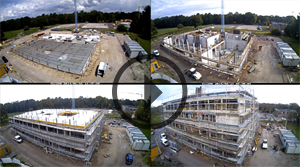News
News
Oldenburg research team creates bright source of single photons from a 2D crystal

By integrating an atomically thin crystal into a tunable micro-resonator, one of the Institute for Physic’s research teams (Quantum Materials) has created a bright source of single photons revealing signs of quantum coherence, a first for this type of device and an exciting step towards accessible single-photon sources.
The article has just been published in Nano Letters: DOI: 10.1021/acs.nanolett.3c02584
Research wind farm WiValdi inaugurated
In Krummendeich near the the Elbe estuary, a unique large-scale research facility was opened on August 15th. The research wind farm WiValdi (short for "Wind Validation"), operated by the German Aerospace Center (DLR) and co-developed by ForWind and Fraunhofer IWES, consists of two state-of-the-art wind turbines packed with sensors and measuring equipment, another test turbine and five meteorological measuring masts.
"Over the past 20 years, ForWind has been involved in a great many wind energy research projects and participated in numerous measurement campaigns on land and at sea. This wealth of experience has been incorporated into the design and content planning of the wind energy research park in Krummendeich and thus forms the basis for ForWind's future research," explains turbulence expert Prof. Dr. Joachim Peinke scientific spokesman for ForWind, as researchers from all three ForWind universities (Oldenburg, Bremen and Hanover) have contributed to WiValdi.
At the heart of the test field, the only one of its kind in the world, are two conventional multi-megawatt class wind turbines, whose rotor blades reach up to a height of 150 metres. One of the turbines stands in the wake of the other. One of the most important research questions: How will turbulence from the front turbine affect the rear wind turbine? To find out, a so-called measuring mast array developed by ForWind is located between them. This arrangement is of significance for the future, because with the currently planned high expansion of new wind turbines and wind farms, the turbines will inevitably be closer together.
The arrangement of sensors specially developed for WiValdi at the University of Oldenburg makes it possible for the first time to measure the turbulent wind conditions between turbines with high temporal and spatial resolution. The measuring devices are installed on irregularly distributed booms, some of them several metres long, at the side of the masts. They are arranged in such a way that they record, for example, wind speed, temperature or humidity in detail on a vertical surface between the two wind turbines. Another measuring mast in front of the front wind turbine records the incoming wind field. The towers and rotor blades of the turbines are also equipped with measuring systems planned and developed by ForWind members at the universities of Bremen and Hanover.
The Wind Energy Research Park is funded by the German Federal Ministry of Economics and Climate Action (BMWK) and the Lower Saxony Ministry of Science and Culture. The Wind Energy Research Park was developed and built by DLR together with the partners of the Research Alliance Wind Energy (FVWE). The FVWE pools the know-how of around 600 researchers to provide impetus for the energy supply of the future. It consists of three participants: DLR, ForWind and the Fraunhofer Institute for Wind Energy Systems (IWES). WiValdi is also open to the wider research community in science and industry for joint projects.
How wind turbines react to turbulence published in PRX Energy
The power output of wind turbines can go up or down by 50 percent within seconds. Such fluctuations in the megawatt range put a strain on both power grids and the turbines themselves. A new study by researchers from the University of Oldenburg and the Sharif University of Technology in Tehran presents a method that could help to prevent these power swings.
The research team led by lead author Dr Pyei Phyo Lin from the University of Oldenburg analysed data from several turbines in a wind farm. “Because wind turbines operate under turbulent wind conditions – similar to a plane landing in strong winds – all the measured data display multiple fluctuations and no clear signal can be detected. We refer to this as ‘noise’,” Lin explained. The physics engineer and his colleagues applied stochastic methods to analyse time series of the wind speed, the electrical output of the turbines and the rotational speed of the generator.
According to the study, it is the control systems of wind turbines that are mainly responsible for short-term fluctuations in electrical output. The research results also point to how these systems can be optimised to ensure that the turbines’ energy output is more consistent. The study was published in the science journal PRX Energy.
Windlab - a research building is taking shape
More news available on the German page: → Aktuelles // Universität Oldenburg (uol.de)



